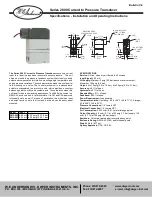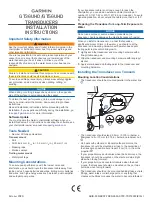
Precautions for Use of Medical Telemeter
WARNING
The LX-7120 transmitter must not be co-located or operated in
conjunction with any other antenna or transmitter.
The LX-7120 complies with FCC radiation exposure limits set forth for a
controlled environment and meets the FCC radio frequency (RF)
Exposure Guidelines in Supplement C to OET65. The LX-7120 has very
low levels of RF energy that are deemed to comply without testing of
specific absorption ratio (SAR).
Operation of LX-7120 requires the prior coordination with a frequency
coordinator designated by the FCC for the Wireless Medical Telemetry
Service.
This radio frequency device is susceptible to interference from outside
sources. Interference may prevent the monitoring of patients connected
to this device. If a problem exists, contact your local service
representative.
The LX-7120 transmits vital signs to the receiving monitor using radio
wave signal. Under unstable radio wave signals, the receiving monitor
will not generate any alarms. This situation may miss sudden change in
the patient's condition and may cause a serious accident. Under
unstable radio wave signals, check the patient status consistently under
this situation. To get stable radio wave signals, make sure to have a
proper telemetry installation.
CAUTION
For installation, make sure the following.
The medical institution (hereinafter referred to as the “Institution”) must
decide the telemetry installation plan for the medical department in order
to prevent interference and interference between transmitters (telemetry
based on destination country’s radio law). When telemetry has already
been installed and been used, radio format, frequency, and antenna power
are required to be examined to prevent interference.
When using telemetry, which requires zone location, the Institution is to
set up the zones as an operation unit for each transmitter to prevent
electronic interference between telemetry throughout the Institution.
When using telemetry, which requires zone location, display and identify
each prepared zone in the equipment.
When laying receiver antenna for each transmitter, the Institution has to
examine the installation so that electronic interference does not occur.
Based on the above examination result, the Institution should install each
receiver antenna as required.
For management, make sure to follow the precautions below.
The Institution should appoint a person (hereinafter referred to as the
“Overall Manager”) to manage the wireless channels for the whole
Institution.
ix
Summary of Contents for LX-7120
Page 18: ...xvi Blank Page ...
Page 22: ...1 General Description 2 Blank Page ...
Page 24: ...2 Names of Parts and Their Functions 4 Blank Page ...
Page 28: ...3 Preparation 8 Blank Page ...
Page 36: ...5 Respiration Monitoring 16 Blank Page ...
Page 44: ...6 Measurement 24 Blank Page ...
Page 50: ...7 Operation 30 Blank Page ...
Page 54: ...8 Other Setting Items 34 Blank Page ...
Page 56: ...9 Changing the Transmitter Channel and Group ID 36 Blank Page ...
Page 62: ...11 Cleaning and Disinfection 42 Blank Page ...
Page 73: ......












































